Axilla
The axilla (also, armpit, underarm or oxter) is the area on the human body directly under the shoulder joint. It includes the axillary space, an anatomical space within the shoulder girdle between the arm and the thoracic cage, bounded superiorly by the imaginary plane between the superior borders of the first rib, clavicle and scapula (above which are considered part of the neck), medially by the serratus anterior muscle and thoracolumbar fascia, anteriorly by the pectoral muscles and posteriorly by the subscapularis, teres major and latissimus dorsi muscle.
| Axilla | |
|---|---|
 Axilla | |
| Details | |
| Artery | axillary artery |
| Vein | axillary vein |
| Nerve | axillary nerve, medial cord, posterior cord, lateral cord |
| Lymph | axillary lymph nodes |
| Identifiers | |
| Latin | Axilla |
| MeSH | D001365 |
| TA98 | A01.1.00.021 |
| TA2 | 140 |
| FMA | 24864 |
| Anatomical terminology | |
The soft skin covering the lateral axilla contains many hair and sweat glands. In humans, the formation of body odor happens mostly in the axilla.[1] These odorant substances have been suggested by some to serve as pheromones, which play a role related to mate selection, although this is a controversial topic within the scientific community.[2] The underarms seem more important than the pubic area for emitting body odor, which may be related to human bipedalism.[3]
Structure
Boundaries
Anatomically, the boundaries of the axilla are:
| superiorly: by the outer border of first rib, superior border of scapula, and posterior border of clavicle[4] | ||
| medially: serratus anterior[5] and by the ribcage | anteriorly: by the pectoralis major, minor,[6] and subclavius[5]
posteriorly: by the subscapularis above, and teres major and latissimus dorsi below[5] |
laterally: by the humerus and the surrounding muscles of the arm (coracobrachialis and biceps brachii)[7] |
| floor/base: by the skin[4] (visible surface of axilla) |
The lower posterior boundary is called the posterior axillary fold and this is a compound structure consisting of the latissimus dorsi and teres major muscles.[8] It can descend after weight loss.[9]
The anterior boundary is called the anterior axillary fold and this is rounded in shape and formed by the lower border of the pectoralis major. Some sources also include the pectoralis minor.[8] It can elongate after weight loss.[9]
The contents of the axilla include the axillary vein and artery, as well as the brachial plexus, lymph nodes and fat. The axilla is the space between the side of the thorax and the upper arm.
Contents
- Axillary artery and its branches
- Axillary vein and its tributaries
- Infraclavicular part of the brachial plexus
- Long thoracic and intercostobrachial nerves
- Five groups of axillary lymph nodes and the associated lymphatics
- Axillary fat and areolar tissue in which the other contents are embedded
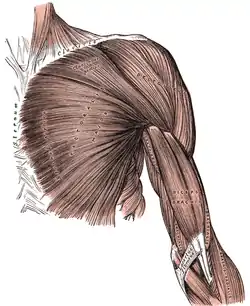 Superficial muscles of the chest and front of the arm.
Superficial muscles of the chest and front of the arm. Axillary artery and its branches - anterior view of right upper limb and thorax.
Axillary artery and its branches - anterior view of right upper limb and thorax. The veins of the right axilla, viewed from in front.
The veins of the right axilla, viewed from in front.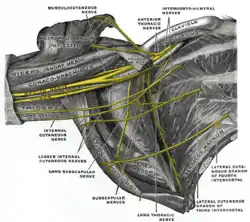 The right brachial plexus (infraclavicular portion) in the axillary fossa; viewed from below and in front.
The right brachial plexus (infraclavicular portion) in the axillary fossa; viewed from below and in front. The left side of the thorax.
The left side of the thorax.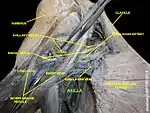 Axilla
Axilla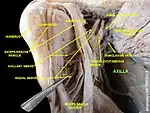 Axilla
Axilla Axilla
Axilla Axilla
Axilla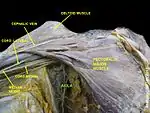 Axilla
Axilla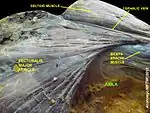 Axilla
Axilla Axilla
Axilla
Society and culture
The term "underarm" typically refers to the outer surface of the axilla. However, the terms are sometimes used interchangeably in casual contexts. Colloquially, underarm refers to the hollow beneath the junction of the arm and shoulder.[10]
Tickling
The underarm is a ticklish area, possibly due to the number of nerves it contains. Most people find this area to be particularly unpleasant when tickled.
Underarm hair
Underarm hair usually grows in the underarms of both females and males, beginning in adolescence.
In some modern Western cultures, it is common for women to remove underarm hair.[11] Some view this practice as an aesthetic matter, while others view its removal for health-related concerns.[12] As underarm hair grows quickly, removal must be performed frequently, or stubble will appear in the axilla. In the Islamic tradition, underarm hair removal is a religious hygiene practice for both women and men. While most Muslims shave it, some pluck it, with products like wax, as it's more efficient to sustain longer periods without regrowing.
In the feminist movement, the hippie culture, and in the punk rock scene, some women retain their underarm hair for a variety of reasons, from subversion to egalitarianism to comfort.[13] Conversely but uncommonly, some men choose to remove their underarm hair for aesthetic reasons or to reduce friction in sports such as swimming.
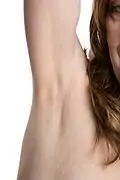 Shaved underarm
Shaved underarm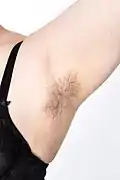 Natural underarm
Natural underarm
Clinical significance
Like other flexion surfaces of large joints (groin, popliteal fossa, cubital fossa and essentially the anterior part of the neck), it is an area where blood vessels and nerves pass relatively superficially, and with an increased amount of lymph nodes.
Lymphogenic spread of breast cancer
Breast cancer typically spreads via lymphatic vessels to the lymph nodes found in the axilla.
Axillary intertrigo
Excessive perspiration without adequate air circulation can result in axillary intertrigo. Intertrigo is an inflammatory skin condition of skin folds exposed to friction or maceration in the presence of heat and moisture.[14] Intertrigo is worsened by infection, usually fungal (Candida yeast species), but also bacterial or viral; warm, wet underarms promote those growths.[15] The condition results in rash-like symptoms, pustules, or chronic itching or burning in the underarm.[14][16] Intertrigo (in any site) has no racial or sexual predilection.[14] Axillary intertrigo is common among those who work in hot environments where air circulation is restricted by necessary clothing or safety equipment.[17]
See also
- Deodorant
- Perspiration
- Popliteal fossa or "knee pit"
- Suspensory ligament of axilla
Notes
- Turkington, Carol; Dover, Jeffrey S. (2007). The encyclopedia of skin and skin disorders (3rd ed.). New York: Facts on File. p. 363. ISBN 978-0-8160-6403-8.
- Drea, Christine M. (February 2015). "D'scent of man: A comparative survey of primate chemosignaling in relation to sex". Hormones and Behavior. 68: 117–133. doi:10.1016/j.yhbeh.2014.08.001. PMID 25118943. S2CID 2973690.
- The Oxford Handbook of Evolutionary Psychology, Edited by Robin Dunbar and Louise Barret, Oxford University Press, 2007, Chapter 22 Body odours and body odour preferences in humans by Claus Wedekind
- "Anaesthesia UK :AnaesthesiaUK: Applied anatomy for upper limb blocks". Archived from the original on 2008-10-16. Retrieved 2007-12-23.
- "LAB #4 PECTORAL REGION & Introduction to the Axilla". Retrieved 2007-12-23.
- "Dissector Answers - Axilla and Arm". Archived from the original on 2007-12-10. Retrieved 2007-12-23.
- Stingl, Josef; et al. (2012). Regional Anatomy. Prague: Galén. p. 95. ISBN 978-80-7262-931-2.
- lesson3axilla at The Anatomy Lesson by Wesley Norman (Georgetown University)
- Hurwitz, D.; Neavin, T. (2007). "Body Contouring of the Arms and Brachioplasty". Handchirurgie · Mikrochirurgie · Plastische Chirurgie. 39 (3): 168–72. doi:10.1055/s-2007-965236. PMID 17602378.
- "Definition of armpit - Merriam-Webster Online Dictionary". Archived from the original on 15 December 2007. Retrieved 2007-12-23.
- "Benefits of shaving armpit hair". Healthline. 28 February 2020. Retrieved 2021-06-22.
- Lanzalaco, Anthony, PhD; Vanoosthuyze, Kristina, PhD; Swaile, David, PhD; Rocchetta, Heather, PhD; Spruell, Russell, MSc; Stark, Cynthia (2016). "A comparative clinical study of different hair removal procedures and their impact on axillary odor reduction in men". Journal of Cosmetic Dermatology. 5 (1): 58–65. doi:10.1111/jocd.12197. PMC 4793925. PMID 26663394.
- "The new feminist armpit hair revolution: half-statement, half-ornament". Guardian News & Media. 24 June 2019. Retrieved 2021-06-22.
- Selden, Samuel, MD. Intertrigo. emedicine, WebMD. March 9, 2007. Accessed May 21, 2009.
- Occupational Dermatoses - A Program for Physicians. National Institute for Occupational Safety and Health. April 17, 2001. Accessed May 21, 2009.
- https://www.cdc.gov/niosh/topics/skin/occderm-slides/images/derm095.gif Photo95-Axillary intertrigo
- Gardner, Stephanie S., MD (14 June 2020). "Intertrigo". WebMD. WebMD. Retrieved June 22, 2021.
External links
- Step by step Video dissection of the Human Axilla showing all relevant anatomy
- 3D animated overview of axillary anatomy (rich media)
- lesson3axilla at The Anatomy Lesson by Wesley Norman (Georgetown University)
- lesson3axillarywalls at The Anatomy Lesson by Wesley Norman (Georgetown University)